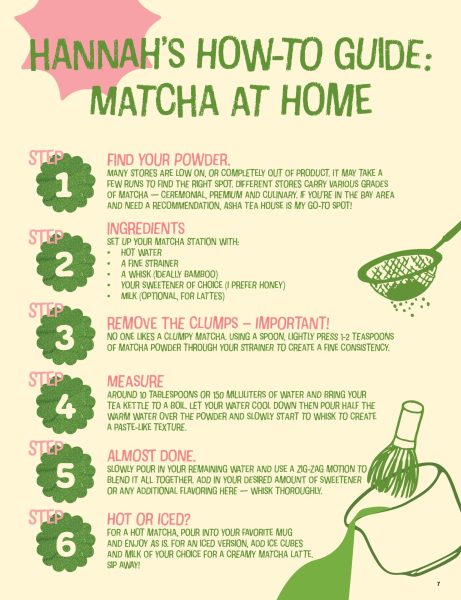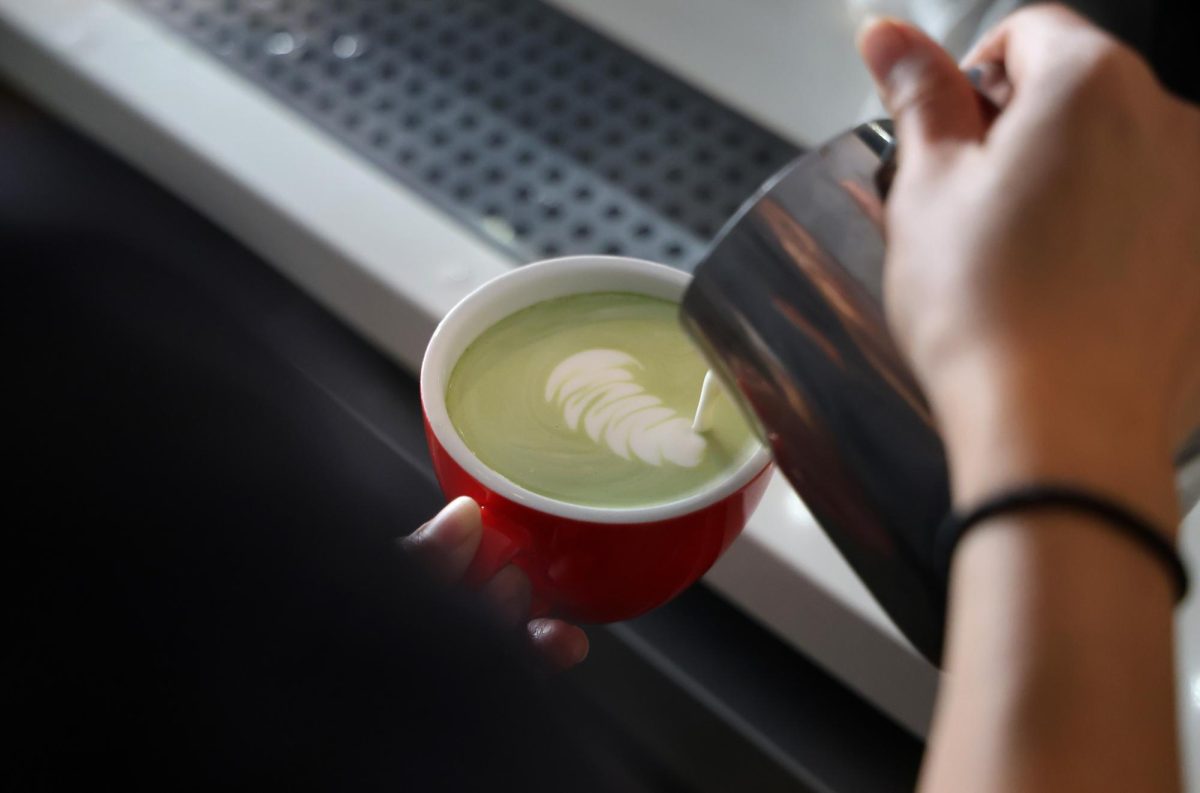From Harvest to Table
Three weeks before harvest, thousands of forest green leaves stretch beneath fine mesh cloth, each leaf protected from the ultraviolet light. Leaves slip between the fingers of Japanese farmers, as they coax them to their richest potential. This process is just the beginning of curating the perfect matcha tea leaf.
After selection, the leaves are quickly given a steam bath to preserve their green color and smooth flavor. They are then dried and de-stemmed to become tencha and ground by a granite mill into a fine powder. Soon, each batch will be graded as either ceremonial, premium or culinary, depending on flavor and quality.
Whether it’s brewing the perfect cup of coffee or steeping fresh tea bags, there is a method to every morning ritual. Now, matcha is a staple in many Americans’ daily caffeine rotation.
According to Marketing Intelo, a market research and business consulting company, in 2024 the global matcha market had an economic value of $1.2 billion and is projected to reach $3.8 billion by 2033.
Matchas popularity is due to a multitude of factors, one being its ability to provide health benefits that link to brain, heart and gut health. According to a 2024 article by AARP, experts from the Department of Nutrition at Harvard believe some health benefits are derived from a very high concentration of antioxidants, providing nutrient-dense properties to consumers.
Because the product is susceptible to oxidation, it is often packaged in airtight containers to protect it from light, heat and moisture, ensuring its flavor and nutrients remain intact. From there, it begins its journey overseas, shipped to distributors around the world.
The ‘Matcha Mafia’
Square, the first mobile credit card reader, reports that of all latte orders in San Francisco, 14% constituted of matcha in January 2025 and increased to 18% in May.
“It’s definitely been prevalent,” said David Lee — owner of Pixlcat, a popular cafe and matcha destination in the Inner Richmond neighborhood — about the demand for matcha. “I always joke around that it’s like the matcha mafia.”
Several cafes and tea houses are now scattered throughout San Francisco. Some of the most popular spots, Shoji Cafe, Tadaima, Stonemill Matcha and more, will have lines of matcha enthusiasts wrapped around the corner, waiting for their perfect cup of green goodness.
Not only do teahouses offer beverages to consume, but unique experiences for customers to enjoy. Junbi Matcha & Tea, in downtown San Francisco, offers monthly networking events, DIY matcha classes, and educates the community about misconceptions regarding the reputation and quality of the product.
Many consumers that are new to the product, can initially be turned off by the earthy, and sometimes bitter taste.
Brian Ng, owner of Junbi, encourages people to try different kinds and grades of matcha, to find their preferred flavor profiles, before making a critical judgement on the product.
Even cafes with no ties to Japanese influence are servicing the demand for matcha. Java Beach Cafe, located in the Outer Sunset, is rooted in Irish heritage — serving Irish soda bread, Barry’s Irish tea and, now, ceremonial grade matcha.
“Each shift that I have there’s always going to be a chain of like four to five matchas, back to back to back,” said Cianna Price, a barista at Java Beach Cafe. “It’s like one person orders one and then all of a sudden everyone behind them is like, ‘oh yeah I want one too.’”
Increased Prices and Low Supply
As the product continues to gain popularity, there is an industry shortage and a pressure to produce high-quality matcha. This forces local shops to increase their prices, otherwise they’ll run out of supply completely.
“We have a really great relationship with our matcha distributor. I don’t wanna put them on blast,” said Lee. “It’s harder to get because it hasn’t been around as long, so the distribution chain is not as mature.”
According to a 2025 business insights article from Yamasan, a global tea distributor in Uji, Japan, the shortage encapsulates more than a temporary supply issue, but an underlying systemic change in Japanese agriculture faltered by erratic climate patterns and an outsized global demand.
“San Francisco is a small city, it’s like seven by seven miles, so it’s almost like everything that happens, happens as like a force multiplier,” said Lee. “Because it’s such a small city, every little change or movement, or fluctuation, is that much more drastic than if you were in a larger city.”
Matcha exports from Japan have more than tripled over the past decade putting pressure on domestic production, Yamasan reports in the article mentioned above. As a result, farmers are struggling to keep up with both global demand and local supply needs.
While the sought after product continues to skyrocket, San Francisco business owners strive to meet the demand of matcha-crazed consumers.
“The most important part is to make sure everyone is leaving here with a smile,” said Lee. “Life is hard in general, it’s hard for everyone and when you’re getting your cup of coffee, or your matcha, that’s one of the joys of your day.”

Hannah’s How-to Guide: Matcha at Home
Step one: Find your powder. Many stores are low on, or completely out of product. It may take a few runs to find the right spot. Different stores carry various grades of matcha — ceremonial, premium and culinary. If you’re in the Bay Area and need a recommendation, Asha Tea House is my go-to spot.
Step two: Ingredients. Set up your matcha station with:
– Hot water
– A fine strainer
– A whisk (ideally bamboo)
– Your sweetener of choice (I prefer honey)
– Milk (optional, for lattes)
Step three: Remove clumps — a vital step. No one likes a clumpy matcha. Using a spoon, lightly press 1-2 teaspoons of matcha powder through your strainer to create a fine consistency.
Step four: Measure around 10 tablespoons or 150 milliliters of water and bring your tea kettle to a boil. Let your water cool down then pour half the warm water over the powder and slowly start to whisk to create a paste-like texture.
Step five: Almost to the finish line. Slowly pour in your remaining water and use a zig-zag motion to blend it all together. Add in your desired amount of sweetener or any additional flavoring here — whisk thoroughly.
Step six: Hot or Iced? For a hot matcha, pour into your favorite mug and enjoy as is. For an iced version, add ice cubes and milk of your choice for a creamy matcha latte.
Sip away!






